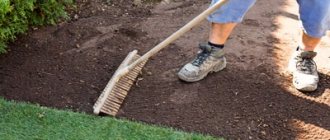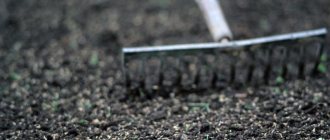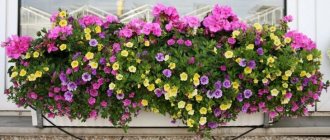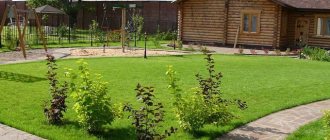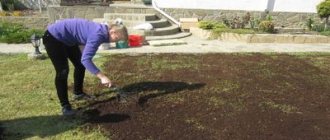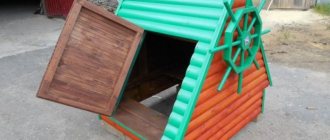The green lawn at the dacha can be used in different ways: to have picnics on it, to play sports, to organize a children's playground. But most often, a trimmed lawn is created as a decorative detail of the landscape. Single planted exclusive or simply beautiful plants, monoflowers, spruce, thuja and other coniferous vegetation look interesting on it.
Each situation places different stress on the grass, so it is important to choose the right grass or seed mixture for your lawn.
The best lawn grasses
To ensure that the green lawn does not require renewal for as long as possible, unpretentious types of grass with a long lifespan are used. Their development from germination to flowering is rather slow, but they remain viable for several years.
Top 10 best perennial lawn grasses:
- Sheep fescue (Festuca ovina L.) is a long-lasting grass with narrow leaves gathered into a dense bush. It grows back immediately after the snow melts, is not afraid of frequent and low mowing, and is highly drought-resistant and also resistant to trampling;
- Red fescue (Festuca rubea) is one of the unpretentious grass plants for the lawn. this type of fescue grows equally well on all types of soil, including poor rocky ones, and is resistant to difficult weather conditions (drought, low temperatures). Used for landscaping problem areas. The root system of the plant forms dense turf that is resistant to mechanical damage. Easily tolerates drought and severe frosts. Life expectancy up to 15 years;
- Meadow bluegrass (Poa pratensis L.) is a frost-resistant grass popular among landscape designers that grows quickly after winter. Numerous thin roots are highly branched, intertwine in the soil for a short time and form a dense elastic turf. Grows well in moist but not swampy areas. Although meadow bluegrass is not very picky regarding soil type, it does not respond well to high acidity;
- Meadow fescue (Festuca pratensis) - forms a powerful bush and, with proper care, remains viable for up to 15 years. Less resistant to trampling than red fescue;
- Common bentgrass (Agrostis capillaries) is a low grass with a thin stem and narrow leaves. Frost-resistant plant, grows on all types of soil, including salt marshes. To create a dense lawn, regular low mowing is recommended;
- Dog bentgrass, or velvet bentgrass (Agrostis canina) is a low-growing frost-resistant grass with rooting shoots. Forms low but dense grass stand. Not afraid of wet areas;
- White bentgrass (Agrostis alba) is a cereal plant that forms a uniform, dense grass stand. Can tolerate flooding during spring floods, afraid of drought. The roots, intertwined in the soil, form a strong, elastic turf;
- Bentgrass (Agrostis stolonifera) - grows well on loam and sandy loam with a high rate of air permeability. Since the root system is superficial, the plant does not respond well to drought. The advantage is the creeping shoots, due to the rapid growth of which the growth of weeds is suppressed.
- Perennial ryegrass, or perennial ryegrass (Lolium perenne L.) is a fast-growing meadow grass that forms a dense dense cover already in the first year of life. Viability is a little over 5 years. Does not develop well in dry, swampy areas and heavy clay soils;
- Beckmania eruciformis is a winter-hardy grass that tolerates flooding well. Powerful roots contribute to the formation of strong turf. The grass is resistant to trampling and grows back quickly after mowing.
Current prices for your city:
Advantages
- Budget savings. You will have to spend the money once, and such a lawn will last for a couple of decades.
- It has a very strong structure, has wear-resistant qualities and is durable.
- No special care required. Sometimes it is necessary to remove fallen leaves.
- Looks good throughout use.
- Resistant to temperature changes and withstands all weather conditions.
- Over time, it does not deform and the surface does not wear off.
- Thanks to such a lawn, you can hide the unevenness of your summer cottage.
- No special skills are required to lay the material.
- Hypoallergenic.
- You can walk barefoot and children can safely spend time on it.
Annual herbs
Since the lawn is not created for one year, annual grasses are practically not used in it. The exception is temporary lawns. For example, it is planned to create a flower garden on the site, but not now, but in a year or two. In this situation, it is advantageous to sow the land with annual or biennial cereals or herbs: an unimproved piece of land will not spoil the landscape, and in due time the soil will be easy to cultivate, since annual plants will not create turf.
There are not many annual grasses for lawns, perhaps due to the fact that they are not in great demand. Most often, only two types are used in landscaping, ryegrass and bluegrass.
Average prices for services
Let's consider the cost of lawn improvement services in the Moscow region.
Preparing areas for lawns
Preparing an area for a lawn is a cultivation procedure in which debris, weeds are removed, and fertilizers are applied.
Next, the soil in the area is compacted. The cost of this procedure depends on the area and composition of the soil. Light soil is sandy or garden soil, as well as soil that was cultivated a year ago.
Loams, clay soils, wetlands and virgin lands, and areas with dense turf are considered difficult types of subgrade. The average price for such a service in the Moscow region is from 70 rubles. for 1 sq. m. area.
Work to prepare a site for sowing lawn grass in the Moscow region includes plowing the site, removing weeds, adjusting the soil, applying fertilizers, leveling, compacting and leveling the surface of the site.
| Plot size (in acres) | Light soil (rub.) | Difficult soil (RUB) |
| Up to 6 acres | 42000 | 57000 |
| 6-8 | 56000 | 76000 |
| 8-10 | 70000 | 95000 |
| 11-12 | 84000 | 114000 |
| 13-15 | 105000 | 142500 |
| 16-20 | 140000 | 190000 |
Sowing lawns
Sowing lawn grass in a prepared area, which includes covering the crops with a rake, will cost 30 rubles. for 1 sq. m of lawn area.
Care
Lawn care includes:
- grass cutting (on average once a week) – 1000 rubles. for 1 hundred square meters;
- manual weeding (as needed) – 80 rub. for 1 sq. m;
- treatment with herbicides (with active growth of weeds) – 900 rubles. for 1 hundred square meters;
- fertilizing (3 times a year) – from 500 rubles. for 1 hundred square meters;
- aeration (1-3 times a year) – 1200 rub.
When and how to sow seeds
Lawn sowing can be done from early spring to September. In spring, this is done from April, when the earth warms up under the sun and the moisture has not yet evaporated. In a humid environment, the seeds quickly swell and begin to germinate. Seeds sown no later than the second ten days of September have time to germinate before the onset of cold weather, and young shoots take root even before the first frost. The root system of plants endures winter with virtually no loss.
You can also sow in the summer, but for this you should choose favorable conditions: in cloudy weather, after rain. To prevent young seedlings from drying out, you need to water the soil all the time until the grass comes into force.
How to seed a lawn:
- Calculate the seed rate for the entire lawn and measure the required amount of seed;
- Divide all the land allocated for the lawn into small, equal-sized plots; Depending on the area, there can be 2, 4, 6 or more (it’s more convenient when you get an even number);
- The mass of seeds is also divided into equal parts according to the number of plots;
- Sow each area with one portion of seeds, scattering them evenly by hand;
- You should move from the sown part in the direction of the not yet sown part.
A few weeks before sowing, the soil is dug up, and a few days later it is leveled with a rake. Immediately after sowing, the soil is leveled again with a rake in order to lightly cover the seeds with soil.
For better contact of the seed with the soil, it is recommended to roll the area with a light roller. It will compact the top layer, and the seeds will begin to germinate faster.
Useful video on planting lawn mixtures:
Features of care
Caring for lawn grass in the Moscow region is not a difficult task if you do all the steps correctly and regularly.
in spring
With the onset of spring, usually in April, you can begin to tidy up the lawn : remove debris, dry leaves and old grass. The only thing you don't need to do in the spring is water and roll the lawn.
In mid-May, when the air temperature has already warmed up to a comfortable level, you need to perform the following steps to get your lawn in order:
- apply nitrogen fertilizer - this will help the lawn grass quickly recover after winter;
- if bald spots have formed on the site over the winter, sow seeds or replace the damaged areas with lawn;
- places on the site where the grass is affected by the fungus should be cleaned and treated;
- when the plants grow more than 9 cm, shorten them to a height of 4-6 cm;
- aerate the area to saturate the soil with oxygen;
- periodically remove sprouted weeds.
In summer
The summer period is the most active and traumatic for grass lawns.
- You should regularly feed the area with complex fertilizers.
- Remove weeds that grow very actively in early summer.
- Treat the grass area with antifungal compounds several times over the summer.
- Water your lawn regularly, but if it rains frequently, watering should be reduced.
- Mow the lawn grass approximately once a week.
- Periodically comb out the grass with a fan rake.
By the end of the summer period, the amount of watering should be reduced.
In the autumn season
With the onset of autumn, the preparation of green lawns for the winter cold begins in the Moscow region. The main thing in autumn care is the removal of debris, fallen leaves, and withered grass from the lawn grass. Before the onset of cold weather, you should do the following :
- reduce watering the grass to a minimum;
- cut the lawn grass no more than 2 times a month;
- be sure to scarify the lawn - comb it, removing all withered grass from the area;
- perform autumn feeding;
- if there are bare areas, sow grass in these areas before winter.
Seed consumption
Seeds of different types of lawn grasses differ in size and density, so seeding rates for specific crops vary. If we take the average parameters (seed size and its density), 30-40 g of seeds per 1 m2 are sown in light, loose soils, and 40-50 g/m2 in heavy soils. If the lawn has a large area, the mass of seed is calculated per 1 hundred square meters and is 3-4 kg on light soils and 4-5 kg on heavy soils.
A significant deviation from the norm in one direction or another is not desirable, as this affects the quality of the lawn. If you take more seeds, their germination is extended over time and occurs more slowly. The sprouts “compete” with each other: those that emerged earlier suppress the growth of late shoots. If less than the norm is sown, seedlings are sparse, uneven, and bald spots remain on the lawn.
Red fescue (Festuca rubra)
Grass No. 2 for use on lawns. There are several varieties of red fescue (named for the anthocyanin coloring at the base of the stem), and there are both rhizomatous varieties (red red, red hairy) and non-rhizomatous varieties (red hard). Professionals often argue among themselves which fescue or bluegrass is better; the question is ambiguous and, apparently, there is no answer to it. For different conditions, either bluegrass or fescue is more suitable. If the soils are light, sandy, and there are problems with watering, fescue is more suitable, after all, it is a plant of the steppe zone and these conditions are more familiar to it. Fescue is less demanding, unlike bluegrass, regarding soil fertility and fertilizing; if you forget to mow it, it will also tolerate this. A sort of “lazy person’s dream.” However, with all its advantages, there are also significant disadvantages; it does not tolerate flooding and soil compaction at all, so it will not grow well on loamy, and even more so on clay soils. Bluegrass tolerates loads much worse, so it is usually not used on sports lawns, but it grows better in the shade (this is mainly due to the fact that it is not affected by powdery mildew in the shade). When sowing fescue in its pure form, it is better to use a mixture of several varieties of fescue, both with and without rhizomes. This is done because hard red fescue can also give bluegrass a head start in terms of resistance to stress, but, unfortunately, it recovers slowly, and due to the lack of rhizomes, it will not be able to fill bald spots. The optimal mixture, in my opinion, is 60% red red, and 20% hair-like and hard. Externally, all three varieties are similar to each other, except that the red hard fescue has a denser bush. Mixtures of red fescue with bluegrass are also quite widely used, in proportions of approximately 80% bluegrass and 20% red fescue, or 70/30. The seeding rate fluctuates around 2-3 kg/area (20-30 g/sq.m.), because fescue seeds are larger than bluegrass seeds, and 1 g. approximately 1000 pieces of red fescue seeds.
Which herb to choose
Typically, seed stores sell ready-made lawn mixtures, and the crops included in them are selected for different growing conditions. Knowing where you plan to make a lawn, you need to buy a mixture that is suitable for the composition of the soil, corresponding to the degree of shading of the area, as well as soil moisture.
Lawn in the shade
Not all meadow grasses tolerate shade; it can be said that only a few lawn plants have the ability to withstand shade. This unique feature is inherent in the bluegrass. It grows well under tree canopies and in the shade of buildings. Even if very little sunlight falls on the lawn, the plant will cover all the bald spots and will not lose its rich color.
Important. Unfortunately, oak grove bluegrass is not resistant to trampling, so it is better not to walk on it. Also, in order to maintain the picturesqueness of the lawn, you will have to give up frequent mowing.
For important places
In low-lying places with constant humidity, the root system of plants becomes wet, and the lawn not only loses its decorative value, it simply dies. On such soil it is recommended to sow swamp bluegrass, which has powerful roots. The plant forms a lush green cover and grows back quickly after mowing. The disadvantage is the short lifespan, which is why you need to constantly sow seeds to maintain the decorative appearance of the lawn.
The main mistake when creating a lawn
It must be said that problems with lawns, as a rule, arise mainly from those people who have chosen the wrong grass mixture.
When choosing lawn grass, a person usually pays attention only to what type of lawn it is intended for - sports or parterre. The last thing owners of country houses are interested in are the types of lawn grasses that are part of the mixture. And many people don’t even look at it. For most people, this information means little. But it is very important, since a large number of different mixtures are imported into our country from the European continent and not all are suitable for the conditions of the Russian climate.
In European countries, the climate is milder and the criteria for selecting grass for the lawn are completely different. Our climatic conditions are harsh , so higher demands must be placed on grass mixtures used to create a lawn.
If the grass purchased to create a lawn does not have frost resistance, then it will not survive the winter well , and in the spring you will have to restore the damaged areas of the lawn.
To avoid all this, you need to take the selection of grass for your lawn seriously and carefully select grass seeds. It is worth considering only those that are adapted to the climatic conditions of our country. How to choose the right lawn grass so that the lawn does not suffer from the Russian climate - this will be discussed in this article.

